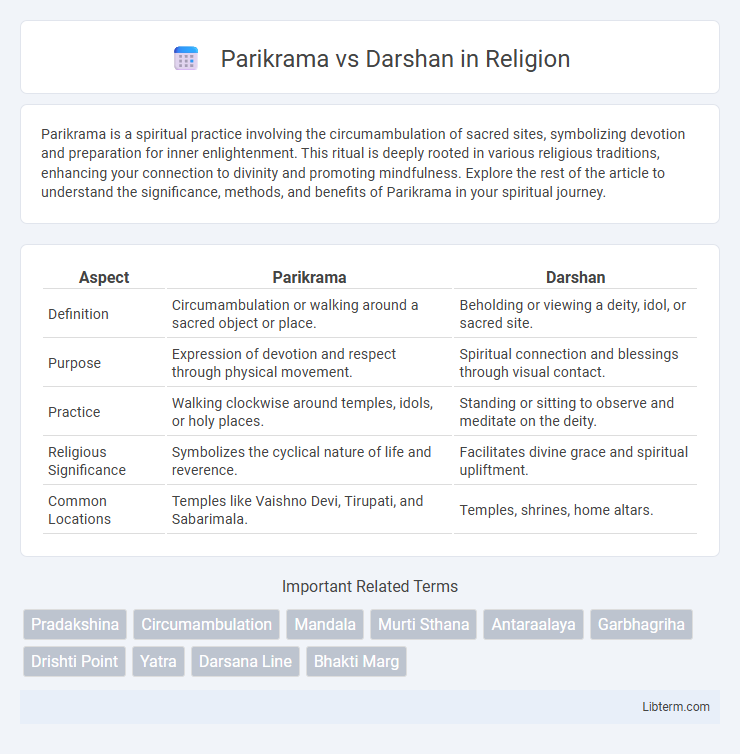Parikrama is a spiritual practice involving the circumambulation of sacred sites, symbolizing devotion and preparation for inner enlightenment. This ritual is deeply rooted in various religious traditions, enhancing your connection to divinity and promoting mindfulness. Explore the rest of the article to understand the significance, methods, and benefits of Parikrama in your spiritual journey.
Table of Comparison
| Aspect | Parikrama | Darshan |
|---|---|---|
| Definition | Circumambulation or walking around a sacred object or place. | Beholding or viewing a deity, idol, or sacred site. |
| Purpose | Expression of devotion and respect through physical movement. | Spiritual connection and blessings through visual contact. |
| Practice | Walking clockwise around temples, idols, or holy places. | Standing or sitting to observe and meditate on the deity. |
| Religious Significance | Symbolizes the cyclical nature of life and reverence. | Facilitates divine grace and spiritual upliftment. |
| Common Locations | Temples like Vaishno Devi, Tirupati, and Sabarimala. | Temples, shrines, home altars. |
Understanding Parikrama: Meaning and Origins
Parikrama, an ancient Hindu ritual meaning circumambulation, involves walking clockwise around a sacred object or site, signifying reverence and spiritual connection. Originating from Sanskrit, parikrama represents the path of devotion that encircles temples, deities, or holy rivers, symbolizing the cyclical nature of life and the universe. Unlike darshan, which emphasizes the direct visual experience of a deity, parikrama embodies an active, meditative practice reinforcing faith through physical movement around the divine.
The Concept of Darshan in Hinduism
Darshan in Hinduism signifies the sacred act of seeing and being seen by a deity, embodying a profound spiritual connection between the devotee and the divine. Unlike Parikrama, which involves circumambulating a deity or sacred site as a form of worship and meditation, Darshan centers on the visual and spiritual encounter that transmits divine blessings and grace. This encounter is considered essential for receiving spiritual merit and deepening one's faith within temple rituals and pilgrimage practices.
Parikrama vs Darshan: Key Differences
Parikrama involves circumambulating a sacred site, such as temples or shrines, as an act of devotion, symbolizing the cyclical nature of life and reinforcing spiritual discipline. Darshan refers to the act of seeing and being seen by a deity or saint, emphasizing a direct spiritual connection and blessing. The key difference lies in Parikrama's physical, meditative movement around the sacred object, while Darshan centers on the visual and experiential reception of divine presence.
Spiritual Significance of Parikrama
Parikrama holds deep spiritual significance as a sacred circumambulation reflecting devotion and surrender to the divine, often believed to cleanse sins and accumulate positive karma. This ritual symbolizes the cyclical nature of life and the universe, promoting mindfulness and connection to the sacred space surrounding temples or pilgrimage sites. Unlike Darshan, which centers on viewing and receiving blessings from the deity, Parikrama emphasizes active participation in worship through movement, enhancing spiritual discipline and focus.
The Essence of Darshan: Seeking Divine Presence
Darshan embodies the profound experience of encountering the divine presence through direct sight, fostering a spiritual connection that transcends physical rituals. Unlike Parikrama, which emphasizes circumambulation as an act of devotion, Darshan centers on the visual and emotional communion with the deity, inviting devotees to absorb divine energy and blessings. This sacred moment of seeing and being seen by the deity serves as the essence of Darshan, nurturing faith and inner transformation.
Ritual Practices in Parikrama
Parikrama is a ritual practice involving circumambulating a sacred site, symbolizing devotion and spiritual journey, predominantly observed in Hindu, Buddhist, and Jain traditions. The act of walking clockwise around temples, deities, or holy rivers reflects respect and reverence, aiming to accumulate positive karma and purify the soul. This physical and meditative practice contrasts with Darshan, which emphasizes visually beholding a deity or sacred object to receive blessings.
Darshan Etiquette: Dos and Don’ts
Darshan etiquette emphasizes maintaining silence, showing reverence, and avoiding distractions like mobile phone usage or photography to respect the sanctity of the space. Devotees should dress modestly, remove footwear before entering the temple, and follow the queue patiently to ensure a smooth and respectful darshan experience. Avoid pushing, rushing, or disrespecting rituals, as these actions disrupt the spiritual atmosphere and fellow devotees' focus.
Parikrama in Temples: Common Routes
Parikrama in temples refers to the ritual circumambulation of the sanctum sanctorum, symbolizing respect and devotion to the deity. Common routes include the outer pradakshina path surrounding the main shrine, often marked clearly for devotees to follow while chanting prayers or mantras. This practice is integral in major temples like Tirupati Balaji, Kedarnath, and Vaishno Devi, where completing the parikrama is believed to enhance spiritual merit and connect devotees deeply with the divine presence.
Symbolism Behind Parikrama and Darshan
Parikrama symbolizes the cyclical nature of life and the universe, representing devotion through circumambulation of a sacred object or place, reflecting respect and reverence. Darshan signifies the direct visual connection with a deity or holy person, embodying the spiritual experience of presence and divine blessing. Both practices emphasize different aspects of faith: Parikrama focuses on movement and continuity, while Darshan centers on sight and spiritual communion.
Parikrama and Darshan: Which Is Right for You?
Parikrama and Darshan offer distinct spiritual experiences, with Parikrama involving circumambulation around a sacred site to engage in meditation and devotion, and Darshan focusing on the direct visual connection with a deity or saint. Choosing between Parikrama and Darshan depends on personal preference for active participation in a ritual or seeking a moment of divine sight for blessings and inner peace. Understanding the purpose of each practice helps individuals select the most meaningful path for their spiritual journey.
Parikrama Infographic

 libterm.com
libterm.com